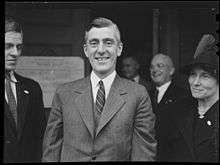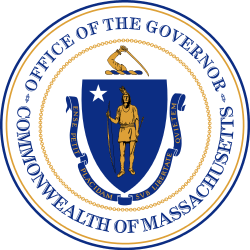Leverett Saltonstall
| Leverett Saltonstall | |
|---|---|
 | |
| Republican Senate Conference Chairmen | |
|
In office January 3, 1957 – January 3, 1967 | |
| Leader |
Kenneth S. Wherry Styles Bridges Robert A. Taft William F. Knowland |
| Vice Chair | Milton Young |
| Preceded by | Eugene Millikin |
| Succeeded by | Margaret Chase Smith |
| Senate Majority Whip | |
|
In office January 3, 1953 – January 3, 1955 | |
| Leader | William F. Knowland |
| Preceded by | Lyndon B. Johnson |
| Succeeded by | Earle C. Clements |
| United States Senator from Massachusetts | |
|
In office January 4, 1945 – January 3, 1967 | |
| Preceded by | Sinclair Weeks |
| Succeeded by | Edward Brooke |
| 55th Governor of Massachusetts | |
|
In office January 5, 1939 – January 3, 1945 | |
| Lieutenant | Horace T. Cahill |
| Preceded by | Charles F. Hurley |
| Succeeded by | Maurice J. Tobin |
| Speaker of the Massachusetts House of Representatives | |
|
In office January 1929 – January 1937 | |
| Preceded by | John C. Hull |
| Succeeded by | Horace T. Cahill |
| Member of the Massachusetts House of Representatives | |
|
In office January 1922 – January 1937 | |
| Personal details | |
| Born |
September 1, 1892 Chestnut Hill, Massachusetts |
| Died |
June 17, 1979 (aged 86) Dover, Massachusetts |
| Resting place | Harmony Grove Cemetery, Salem, Massachusetts |
| Political party | Republican |
| Spouse(s) | Alice Wesselhoeft Saltonstall |
| Alma mater | Harvard University |
| Religion | Unitarian |
| Military service | |
| Service/branch | United States Army |
| Years of service | 1917−1919 |
| Rank | First Lieutenant |
| Battles/wars | World War I |

Leverett A. Saltonstall (September 1, 1892 – June 17, 1979) was an American Republican politician who served as the 55th Governor of Massachusetts (1939–1945) and as a United States Senator (1945–1967).
Life and career
Saltonstall was born in Chestnut Hill, Massachusetts, and was a longtime summer resident of Vinalhaven, Maine. As an adult he spent winters on his family estate in Dover, Massachusetts, where he liked to farm. His father was Richard Middlecott Saltonstall, a lawyer; his mother, Eleanor Brooks Saltonstall, was the daughter of a multimillionaire, Peter C. Brooks. He married Alice Wesselhoeft (1893–1981) in 1916, and together they had six children, including Emily (1920–2006), at one time the daughter-in-law of Richard Byrd and a former WAVE; Peter Brooks Saltonstall, killed in action on Guam on August 13, 1944; William L. Saltonstall (1927–2009), a former member of the Massachusetts Senate; and Susan (1930–1994), a horse breeder.
Part of the Boston Brahmin Saltonstall family, he was able to trace his ancestral roots to the Mayflower, the Pilgrims and the Massachusetts Bay Colony. Saltonstall was the tenth generation in direct descent to graduate from Harvard and the great-grandson of a U.S. Congressman of the same name.
A graduate of the private Noble and Greenough School, he graduated from Harvard College in 1914, where he was captain of the Junior Varsity crew that won the prestigious Grand Challenge Cup at the Henley Royal Regatta – the first American crew ever to do so–and Harvard Law School in 1917. Saltonstall also played hockey at Harvard where he scored a dramatic overtime goal in 1914 for Harvard to beat the legendary Hobey Baker's Princeton team. "Salty" also rowed and played football at Harvard.
Prior to being admitted to the bar, he served as a first lieutenant in the United States Army in the 301st Field Artillery Regiment in the 76th Division during and after World War I from 1917 to 1919.
Saltonstall, a Republican, entered politics as an alderman in Newton, Massachusetts from 1920 to 1922, while simultaneously serving as an assistant district attorney of Middlesex County from 1921 to 1922. He was elected to the Massachusetts House of Representatives that same year; there he rose to the position of Speaker of the House, which he held from 1929 to 1937.
Governor of Massachusetts
In 1936, he was defeated in the election for Lieutenant Governor of Massachusetts, but he made a resounding political comeback two years later when he was elected Governor of Massachusetts, a position he held for three terms from 1939 to 1945.
During that period, Governor Saltonstall mediated a Teamsters strike, reduced taxes, and retired 90 percent of the state's debt. He served as President of the National Governor's Association from 1943 to 1944. While he was Governor, the Cocoanut Grove fire occurred in Boston. In 1944, he also served as the fifth President of the Council of State Governments.
U.S. Senator
In 1944, he was elected to the United States Senate in a special election to fill the unexpired term created by the resignation of U.S. Senator Henry Cabot Lodge, Jr. He was re-elected three times to the U.S. Senate, serving from 1945 to 1967. Those he defeated included John H. Corcoran in 1944, John I. Fitzgerald in 1948, Foster Furcolo in 1954, and Thomas J. O'Connor, Jr. in 1960. During his tenure in the Senate, he served as the Senate Republican Whip and on five influential Senate committees. He also served as the chair of the Senate Republican Conference, 1957–1966.
Death and legacy
Leverett Saltonstall died of congestive heart failure in 1979 aged 86, and is buried in Harmony Grove Cemetery in Salem, Massachusetts. The Saltonstall Building in downtown Boston is named for him.
External links
- United States Congress. "Leverett Saltonstall (id: S000021)". Biographical Directory of the United States Congress. Retrieved January 25, 2008.
- "Leverett Saltonstall". Find a Grave. Retrieved January 25, 2008.

